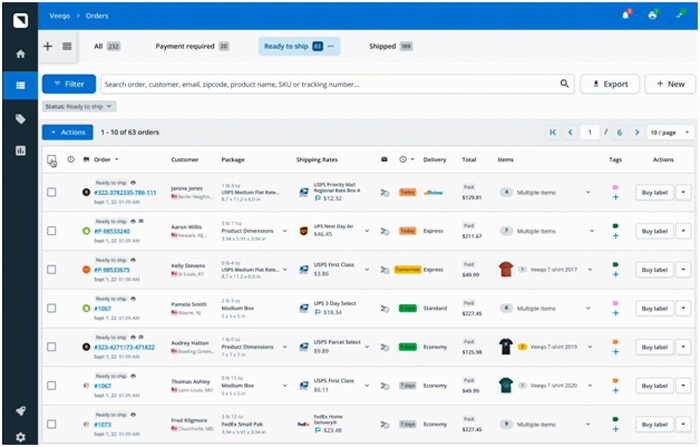
If your ecommerce business incurs more costs than it brings in revenue, it’s time to re-assess and refine your current strategy and operations. Running an ecommerce business can be a rewarding and profitable venture. However, it can also be challenging, especially when cutting costs and maximizing efficiency.
Research data shows that 90% of ecommerce businesses fail within the first 120 days after launch. While many factors can contribute to a failed ecommerce venture, one of the biggest reasons is when your business racks up expenses and doesn’t bring in enough sales.
Fortunately, there are goal-crushing strategies to increase traffic and sales on your ecommerce store while running your business successfully and saving money. Let’s start with the five tactics below.
1. Streamline your order shipping process
A seamless shipping process helps ensure you deliver orders on time and avoid unnecessary additional costs.
It can also provide the following benefits:
- Improve customer satisfaction. A streamlined shipping process gets orders to customers efficiently and on time. When customers receive their orders promptly, and without any issues, they are more likely to be satisfied with their overall shopping experience. It can lead to your business getting more return customers and, in turn, sales.
- Increase sales. Reducing the time it takes to process and ship orders allow you to offer faster delivery options and meet the growing demand for instant gratification among your customers. It can make your business more competitive and help you attract more customers, increasing your sales opportunities.
- Reduce costs and increase profitability. An efficient shipping process can help your business minimize errors, avoid unnecessary expenses, and optimize resources. It can lower your shipping costs and get you higher margins, contributing to your business’s overall success.
Some of the proven shipping tips for small businesses is to use reliable shipping software to speed up your shipping process.
For example, Veeqo offers automation tools that help streamline order shipping, including automatically choosing the best and lowest rates for individual and bulk orders.

Image source: veeqo.com.
The platform can also send automated email tracking links to customers and be configured to select labels based on your pre-set shipping rules automatically.
Implement the right strategies and tools to streamline your shipping process.
It can help you manage your shipping workflows more efficiently while improving customer satisfaction, saving money, and boosting sales.
2. Use automation tools
Besides using automation to streamline your order shipping, leverage it for your other business processes and tasks. Automating repetitive and manual tasks can help you save time, money, and resources while getting things done more efficiently. Automate where it makes the most sense.
For example, you can use an email automation tool to send automated emails to customers based on certain triggers, such as abandoned carts or customer reviews. Another example is to use a project management tool to streamline your workflow and keep track of tasks and deadlines.
Let’s say you’re creating a series of blog posts on content writing tips and tricks as part of your SEO campaign for your ecommerce website. You can automate assignments, follow-ups, and other tasks related to the campaign with your project management tool.
Whether you run an ecommerce business or app development company, there are countless tools you can leverage to streamline business operations and workflows.
Some of these include popular email marketing software, Customer Relationship Management Systems (CRMs), and robust ETL testing automation tools.
3. Use free or low-cost tools and resources
You can run your ecommerce business more efficiently without spending thousands of dollars on resources and software.
Look for free or affordable tools and resources available online that can make managing and running your ecommerce business operations more efficient.
Start with the following tools:
- Google Analytics. Track and analyze data about your website’s traffic and performance using Google Analytics. The tool lets you see the number of people visiting your site, where they come from, and what they do when they get there.
- Shopify’s business name generator. Come up with business name ideas that are catchy and memorable with Shopify’s business name generator. Enter keywords related to your business, and the tool generates a list of potential names for you to choose from.
- Canva. Free graphic design tool Canva allows you to create professional-looking graphics and designs for your website and social media. It has a wide range of templates and tools that simplify creating high-quality graphics even without design experience.

Image source: canva.com.
It can be a great tool to help jumpstart your efforts to develop branding for a small business.
- Google’s Keyword Planner. Use Keyword Planner to identify the most effective keywords for your website and online marketing campaigns. Enter keywords related to your business, and the tool provides data on search volume and competition for those terms. The tool can help you make content marketing work in a world saturated with content.
4. Consider dropshipping
Dropshipping lets you sell products online without holding, storing, or managing physical inventory. When a customer places an order, you pass the order along to the supplier, who ships the product directly to the customer.
Dropshipping can be a huge cost-saver since you won’t need to invest money and resources on storage and shipping costs. Plus, you can run an entire ecommerce business with a laptop and desk (or couch). You can also use the right tools to streamline your dropshipping ecommerce business further.
For example, ExportYourStore lets you export products, including photos, descriptions, stock numbers, etc., from online marketplaces to your ecommerce store easily.
Learn more about using the platform for your ecommerce business from this ultimate review of ExportYourStore.
5. Outsource tasks
You don’t have to shoulder everything to run your ecommerce business successfully. Sometimes, the most practical option workload-wise is to outsource tasks that you need more skills or time for.
Outsourcing can save you money if you spend more time and resources handling a task yourself than having professionals do it. Assess which tasks and areas in your ecommerce business can be more cost effective to outsource.
Some tasks you can outsource to reliable third-party service providers can include:
- Social media management. Streamline your social media marketing campaigns by outsourcing to a reliable agency. Opt for agencies that use top-tier social media management tools such as SocialPilot, Hootsuite, and Vista Social.
- Customer service. Outsource tasks such as answering customer inquiries, handling complaints, and processing returns and exchanges to a customer service provider.
- Photography. Work with a professional photographer if you need product photos or other visual content types for your website or marketing materials.
- Website design and development. If you don’t have the skills or time to design and develop your website, outsource your web development to a reliable web design and development agency to build a great website for ecommerce.
- Content creation. Outsource tasks such as blog post writing, product descriptions, and email marketing campaigns to a content creation agency.
- SEO. Consider outsourcing SEO tasks such as keyword research, on-page optimization, and link building to an SEO agency to improve your website’s ranking in search engine results.
- Financial management. You can hand over your bookkeeping, invoicing, and payroll tasks to a financial management provider with more time and expertise than you.
You can also outsource these tasks to freelancers.
Use platforms such as UpWork or Fiverr to find freelancers to work with.

Image source: fiverr.com.
Optimize your ecommerce store on a budget
Running an ecommerce business can be challenging, especially when you’re on a tight budget.
However, using the hacks and strategies outlined in this guide can help you operate your business more efficiently and effectively while cutting costs.
Photo by Kampus Production
